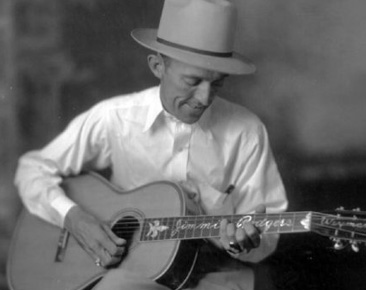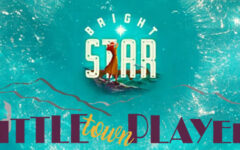
 On Monday, May 26th, it has been 81 years since the passing of Jimmie Rodgers. A titan of American music, Jimmie Rodgers is considered an influence in country, bluegrass, folk, jazz, blues, rock, pop, Americana, and more.
On Monday, May 26th, it has been 81 years since the passing of Jimmie Rodgers. A titan of American music, Jimmie Rodgers is considered an influence in country, bluegrass, folk, jazz, blues, rock, pop, Americana, and more.
In six short years, “The Father of Country Music” left behind a musical legacy which is still relevant in today’s popular culture. As we remember Jimmie’s passing, I will be featuring some “Rodgers Remembrances” and discussing Jimmie’s impact on bluegrass music.
The sweetest girl in the world
Is my blue-eyed Jane
We fell in love like turtle doves
While the moon was shining down
I asked her then I asked her when
The wedding bells would ring
She said, oh dear, it seems so clear
That this could happen here
Yeah, you are my little pal
And I never knew a sweeter gal
My little blue-eyed Jane
I love you so
And when the sun goes down
And the shadow’s creeping over town
Just meet me in the lane
My blue-eyed Jane
Jannie dear, listen here
I’ve come to say farewell
The world is drear without you dear
But now, I cannot linger here
I’m going away, this very day
Oh, please, come go with me
I’ll be sad and blue, I’m wanting you
Longing all day through
My little, blue-eyed Jane
You’ll always be the same sweet thing
I know, you’ll never change
I love you so
And when the sun goes down
And the shadow’s creeping over town
Then I’ll come back again
My blue-eyed Jane
And when the sun goes down
And the shadow’s creeping over town
Then I’ll come back again
My blue-eyed Jane
A lesser known Jimmie Rodgers song, My Blue-Eyed Jane is more of a swing tune than anything else. Although known as the “Father of Country Music,” My Blue-Eyed Jane serves as a potent reminder that the title (while accurate) is limiting. A pioneer in essentially all forms of American music, Jimmie’s recording of My Blue Eyed Jane is as atypical of a country song as one could get.
The song is very addictive. It requires more than one listen. The Dixieland-style trumpet, clarinet, and piano may be off-putting to bluegrass and country purists, but those who allow that to deter their listening are missing out. The vaudeville-ish style hearkens to days long gone. Lovers of music will be able to appreciate the purity of the music being presented.
Jimmie’s vocal delivery is some of his finest. He seems so relaxed. The ease with which he sings each line gives the song a backporch feel which draws in the listener. He gathers steam as the song moves along, and he lets it all loose on the final chorus alongside the pounding barroom piano. From this recording, its easy to see why Jimmie is pointed to as one of the first recorded singers to present songs with heart, soul, and authenticity.
The song itself is wonderfully simple. It’s a classic tale of boy meets girl, boy can’t be without girl, then boy must leave girl. Although, on the surface, the song’s ending is somewhat sad, the lover’s promise to come back again makes the My Blue-Eyed Jane surprisingly optimistic. The vigor with which the song is delivered seems to have a “love conquers all approach,” and there seems to be little doubt that the lovers will be reunited.
My Blue-Eyed Jane is a perfect reminder of the Earl Scruggs quote, “The beauty of simplicity shall never be surpassed.” The straightforwardness of the lyric mixed with an honest delivery makes for a memorable recording.
 Unsurprisingly, there are few bluegrass recordings of My Blue-Eyed Jane. Apparently, Bill Monroe was known to have performed the song live on the Grand Ole Opry from time to time, although no commercial recordings of Monroe doing the song are known (to my knowledge) to exist. However, Doc Watson delivers a terrific rendition on his album, Portrait.
Unsurprisingly, there are few bluegrass recordings of My Blue-Eyed Jane. Apparently, Bill Monroe was known to have performed the song live on the Grand Ole Opry from time to time, although no commercial recordings of Monroe doing the song are known (to my knowledge) to exist. However, Doc Watson delivers a terrific rendition on his album, Portrait.
Doc’s covering of the song should come as no shock. Doc Watson recorded at least eighteen Jimmie Rodgers songs in his career, more than any other bluegrass artist. Jimmie Rodgers was one of Doc’s biggest musical influences.
Here’s Doc from Barry Mazor’s excellent book, Meeting Jimmie Rodgers…
“My interest in Jimmie Rodgers started, believe it or not, when Dad used to bring the recordings home, even before I ever went to school. That goes way back there. Dad and the boys worked at the saw mill, and got a little ‘graohaphone,’ we called it, a little wind-up job that sat on a table, and when Dad started it, I thought we had the king’s treasure in the house. I think I was about six when they got that thing, and I tell you, I was absolutely spellbound. I would be a-settin’ close so I could here it all. Then, when the Jimmie Rodgers recordings started to come into the home, I found something that I was welded to.
Jimmie Rodgers has always been a favorite; I liked the kind of songs he did. To me, they were adventure, and hobo trips, and all that kind of thing—besides the good sound, and those lyrics, they way they were put together. It was a different sound, totally different from all other music … Listening to the records, I learned; by the time I was eleven or twelve, I could yodel in D! I’d go out and yodel so big you could hear it echo … I tried to stay pretty close to what Jimmie did with it. My yodel cross”over from a regular to falsetto wasn’t quite as clean as Jimmie’s; that’s a gift given a person.”
In addition to citing Jimmie’s music as an impact on his singing, Doc also pointed to Jimmie as an early influence on modern guitar.
“Jim played the best he could, because he hadn’t studied music and timing … but I’ll put it this way: some of the first guitar licks I learned were what he was doing. I may have added a few more notes in the runs, but I loved what he was doing with the guitar. He wasn’t a Chet [Atkins], or somebody like that, but he played what he played and he played it well. His funny way of putting a bunch of chords in, in certain songs, even between the lines sometimes, which he’d then get back on, to sing and pick—I kind of liked that. He was one of the fellahs who laid some groundwork in guitar playing; most people never realize that–those basic runs and things, and also some of the things he did later in his career—because he got better.”
In true Doc fashion, he makes Jimmie’s Blue-Eyed Jane his own. He gives the song a bluesy makeover. You wouldn’t guess that it was originally recorded in a Dixieland style. In addition to Doc’s powerful blues-flavored guitar, Mark O’Connor adds some beautiful fiddle playing on this old song. Doc’s ability to resurrect this old song, nearly sixty years after it was first released, and make it relevant and accessible to his modern audience shows why he was one of the greatest song interpreters in American music.
If you have enjoyed the Rodgers Remembrances, I encourage you to tune in to my annual Jimmie Rodgers Tribute Special radio program this afternoon. I will be saluting Jimmie from 3:00-5:00 p.m. EST on the Classic Country Radio network, which includes live streaming at myclassiccountry.com and the “Classic Country Radio” app for smartphones and tablets. The program will include a mix of bluegrass, country, and Americana music as we honor the life and times of one of America’s greatest musical icons.







